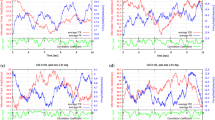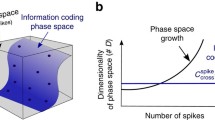Abstract
On the basis of the recent discovery that precisely replicating triplets of impulses present in All-Interval histograms of spike trains generated by visual cortex cells of Rhesus monkeys are surrounded by multiple copies of “ghost doublets” of such triplets, we have examined and compared in detail, the spike trains generated by four complex cells in the striate cortex of curarized monkeys with respect to: (1) The number of precisely replicating triplet patterns embedded in trains of discharges generated in response to specific Hubel-Wiesel stimulation; (2) The effect of time separating the occurrence of such replicating triplets on the number and time distribution of their ghost doublets; (3) The effect of decreasing the precision criterion for the detection of replicating (parent) triplets (from the standard 0.14 ms criterion to 0.5 ms) on the relationships between triplets and their ghosts and (4) The comparison of the distributions in time of ghost doublets around the first and second copies of triplets when the time intervals separating them were greater than or less than 0.5 s. We found that the precision of replication of triplets varies somewhat from one cell to another, and that ghosts doublets are more copiously associated with replicating triplets emitted near in time to each other than with triplets emitted after larger time intervals, except in the case of one cell. In order to assess the statistical significance of our findings, we systematically shuffled the order of occurrence of intervals in every burst of all the records of one of the studied cells and repeated the analysis. Both the number of replicating triplets and of associated ghost doublets is significantly depressed (but not totally obliterated) by the above shuffling procedure. Finally, further implications based on a model of neural information transmission in the form of temporal correlations between spikes are discussed.
Similar content being viewed by others
References
Barlow HB (1963) The information capacity of nervous transmission. Kybernetik 2:1
Bienenstock E, Von der Malsburg C (1987) A neural network for invariant pattern recognition. Europhys Lett 4:121–126
Bullock TH (1962) Transfer functions at synaptic junctions. In: Information processing in the nervous system. Proc. Internat. Union Physiol. Soc., 22nd Congress Leiden. Excerpta Med Found 3:98–108
Dayhoff JE, Gerstein GL (1983) Favoured patterns in spike trains. I Detection. J Neurophysiol 49:1334–1348; II Applications. J Neurophysiol 49:1349–1363
Ferster D, Lindstrom S (1982) An intracellular analysis of the geniculo-cortical connectivity in area 17 of the cat. J Phys 342:181–215
Frostig RD, Frostig B, Frysinger RD, Schechtman VL, Harper RM (1985) Multineuron analysis reveals complex patterns of interaction among neurons in forebrain networks and cardiorespiratory parameters during sleep-waking states, Abstracts of the Society for Neurosciences 15, No 300.2, 1020
Gabott PLA, Martin KAC, Whitteridge D (1987) Connections between pyramidal neurons in layer 5 of cat visual cortex (area 17). J Comp Neurol 259:364–381
Gerstein GL, Kiang NYS (1960) An approach to the quantitative analysis of electrophysiological data from single neurons. Biophys J 1:15–28
Gilbert CD (1983) Microcircuitry of the visual cortex. Ann Rev Neurosci 6:217–247
Grinvald A (1985) Real-time optical mapping of neuronal activity: from single growth cones to the intact mammalian brain. Ann Rev Neurosci 8:263–305
Grinvald A, Manker A, Segal M (1982) Visualization of the spread of electrical activity in rat hippocampal slices by voltage-sensitive optical probes. J Physiol 333:269–291
Hamos JE, Van Horn SC, Raczkowski D, Sherman SM (1987) Synaptic circuits involving an individual retinogeniculate axon in the cat. J Comp Neurol 259:165–192
Hopfield JJ, Tank DW (1986) Computing with neural circuits: a model. Science 233:625–633
Hubel DH, Wiesel TN (1968) Receptive fields and functional architecture of monkey striate cortex. J Physiol (London) 195:215–243
Klemm WR, Sherry CJ (1981) Serial ordering in spike trains: what's it “trying to tell us”? Int J Neurosci 14:15–33
Legendy CR, Salcman M (1985) Burst and recurrences of bursts in the spike trains of spontaneously active striate cortex neurons. J Neurophys 53:926–939
Lestienne R, Strehler BL (1987a) The all-interval paradigm and analysis of the structure of neuronal spike trains. Abstr Society for Neurosci 13, No 231.2, 84
Lestienne R, Strehler BL (1987b) Time structure and stimulus dependence of precisely replicating patterns present in monkey cortical neuronal spike trains. Brain Res 437:214–238
Lorente de No R (1939) Transmission of impulses trough cranial motor nuclei. J Neurophysiol 2:401–464
McGuire BA, Hornung J-P, Gilbert CD, Wiesel TN (1984) Patterns of synaptic input to layer 4 of cat striate cortex. J Neurosci 12:3021–3033
McKay DM, McCulloch WS (1952) The limiting information capacity of a neuronal link. Bull Math Biophys 14:127–135
Marczynski TJ, Burns LL Marczynski GT (1980) Neuronal firing patterns in the feline hippocampus during sleep and wakefulness. Brain Res 185:139–160
Moore GP, Perkel DH, Segundo JP (1966) Statistical analysis and functional interpretation of neuronal spike data. Ann Rev Physiol 28:413–522
Optican LM, Richmond BJ (1987) Temporal encoding of twodimensional patterns by single units in primate inferior temporal cortex. III. Information theoretic analyis. J Neurophysiol 57:162–178
Richmond BJ, Optican LM (1987) Temporal encoding of twodimensional patterns by single units in primate inferior temporal cortex. II. Quantification of response waveform. J Neurophysiol 57:147–161
Richmond BJ, Optican LM, Podell M, Spitzer H (1987) Temporal encoding of two-dimensional patterns by single units in primate inferior temporal cortex. I. Response characteristics. J Neurophysiol 57:132–146
Rodieck RW, Kiang NYS, Gerstein GL (1962) Some quantitative methods for the study of spontaneous activity of single neurons. Biophys J 2:351–368
Sheppard JJ (1968) Human color perception, a critical study of the experimental foundation. Elsevier, New York, pp 133–137
Sherry CJ, Bavrow DL, Klemm WR (1982) Serial dependencies and Markov properties of neural interspike intervals from rat cerebellum. Brain Res Bull 8:163–169
Strehler BL (1969) Information handling in the nervous system: an analogy to molecular-genetic coder-decoder mechanisms. Persp Biol Med 12:584–612
Strehler BL (1977) Time, cells, and aging (2nd edn.). Academic Press, New York, pp 324–356
Strehler BL (1983) Fundamental mechanisms of neuronal aging. In: Cervos-Navarro J, Sarkander HI (eds) Brain aging, neuropathology and neuropharmacology, aging, vol 21. Raven Press, New York, pp 75–91
Strehler BL, Lestienne R (1986) Evidence on a precise timecoded symbols and memory of patterns in monkey cortical neuronal spike trains. P.N.A.S. 83:9812–9816
Strehler BL, Lestienne R (1988) The presence of ghost doublets of coded neuronal patterns: relation to synaptic memory storage. Synapse: (to be published)
Von der Malsburg C, Bienenstock E (1987) A neural network for retrieval of superimposed connection patterns. Europhys Lett 3:1243–1249
Wilbur WJ, Rinzel J (1983) A theoretical basis for large coefficient of variation and bimodality in neuronal interspike interval distributions. J Theor Biol 105:345–368
Author information
Authors and Affiliations
Rights and permissions
About this article
Cite this article
Lestienne, R., Strehler, B.L. Differences between monkey visual cortex cells in triplet and ghost doublet informational symbols relationships. Biol. Cybern. 59, 337–352 (1988). https://doi.org/10.1007/BF00332924
Received:
Published:
Issue Date:
DOI: https://doi.org/10.1007/BF00332924




